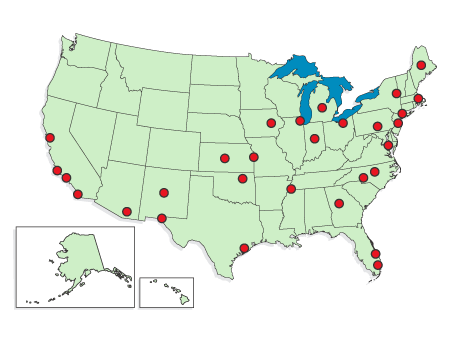Community Impact
- AmeriCorps/Caring Counts
- Community Partners
- Community Partnership Expansion
- GENERATIONS II
- Gulf Coast HIV/AIDS Relief Fund
- Prison Health Initiative
- Southern REACH
- Syringe Access
Receive our e-newsletter
Category List
Community Partners
In 1988, a consortium of national private foundations and corporate donors came together to combine financial resources at the national level and re-distribute those funds to those who needed them most in the battle against HIV/AIDS – community-based organizations across the United States. The unique model that emerged – the Community Partnership Model – remains the essence of the National AIDS Fund as an organization and a funder.
The National AIDS Fund has had Community Partnerships in 39 cities or regions in 27 states and the District of Columbia since 1988. These Partnerships are typically consortia of concerned business, philanthropic, and community leaders dedicated to supporting HIV/AIDS prevention and care in their communities and regions. Community Partnerships were established based on a community’s HIV/AIDS incidence, an existing infrastructure to raise and sustain funding, and geographic diversity.
Nationally, our network of Community Partnerships represents an infrastructure for channeling national resources to local programs across the country that can best utilize that support. At the state and local levels, Community Partnerships serve not only as collaborative fundraising and grantmaking bodies, but also often as conveners, technical assistance providers, community builders, and policy advocates.
The primary function of the Community Partnership Model is to raise, leverage and invest resources. The model works like this:
The National AIDS Fund collaborates with national and multi-national businesses and philanthropic organizations that provide financial resources to a grantmaking pool or for strategic initiatives. The National AIDS Fund then strategically structures and directs those funds to community-based organizations through Community Partnerships around the country. Community Partnerships typically qualify for their grants by raising matching local dollars.
Each Community Partnership determines the best and most efficient distribution of the grant funds in its area, based on the results of a community-based needs assessment. The Partnerships then allocate funds to agencies in their communities coordinating effective HIV prevention programs and providing direct support to persons living with HIV/ AIDS. Community Partnerships often use these private funds to close service gaps where public funds are not reaching.
The Community Partnership Model increases support at every level. Both national and local funders know their contributions are matched and will have a greater impact, making them more enthusiastic about donating to the cause. Increased national and local giving often sparks grant making in communities where no such support previously existed. Most importantly, local AIDS organizations providing prevention programs and direct services have access to more resources for new or existing programs.

